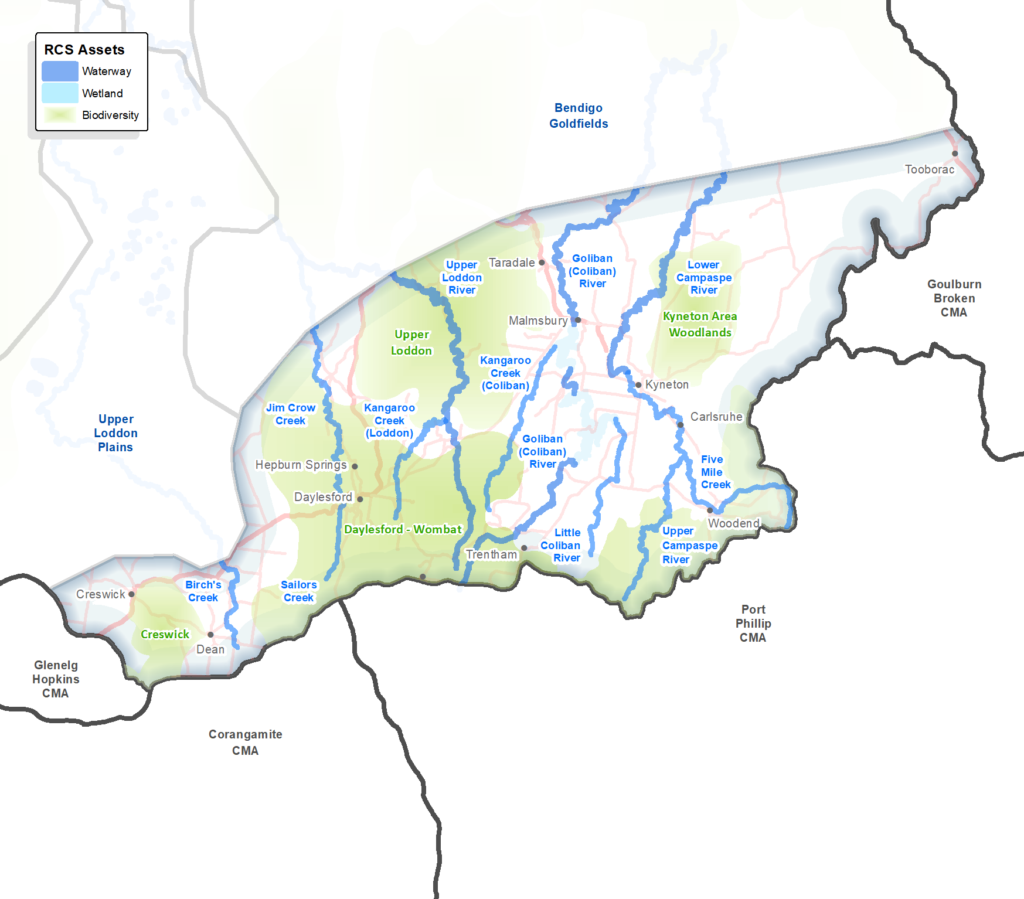Introduction
The Southern Uplands includes the traditional lands of the Dja Dja Wurrung (west of Campaspe River and Five Mile Creek) and Taungurung (east of Campaspe River and Five Mile Creek) peoples.
This is the southern fringe of the region, centred around the Calder corridor between Woodend and Malmsbury, and extending west to Creswick. Many residents commute to Melbourne and Ballarat for work. Accessibility, affordability (compared to Melbourne) and amenity values are driving strong population growth including in rural residential development.
This area has the highest elevation and rainfall in the region, includes the upper reaches of the Campaspe, Goliban (Coliban) and Loddon Rivers, and is entirely within a declared special water supply catchment area. The Macedon Ranges has been declared a Distinctive Area and Landscape, which designates long-term settlement boundaries for townships expected to grow, and provides for better protection and enhancement of natural and rural landscapes. Being within a 100 km radius of Melbourne the Planning for Melbourne’s green wedges and agricultural land project is also relevant to this Local Area. This planning aims to strengthen planning controls to protect values, including to manage land use to support long term agricultural use.
Mineral springs around Daylesford are major a tourism drawcard, along with agritourism attractions and fine restaurants for weekenders from Melbourne.
There is a relatively high proportion of remnant native vegetation, including within the Wombat State Forest, Castlemaine Diggings National Heritage Park and the Hepburn Regional Park, the latter which is jointly managed by Parks Victoria and Dja Dja Wurrung.
When asked about their long-term vision through RCS renewal engagement, respondents from this Local Area spoke about; diverse and connected landscapes, healthy waterways, alternative/sustainable agricultural practices, and an active and engaged community.

A snapshot
| Aspect | Description |
| Key RCS partners | Traditional Owners: Dja Dja Wurrung, Taungurung DELWP, Parks Victoria, Trust for Nature and Agriculture Victoria Local Government: Macedon Ranges, Hepburn, Mitchell and Mt Alexander Shires Landcare Networks: Upper Campaspe, Blampied Kooroocheang, Connecting Country Water corporations: Goulburn Murray Water (rural), Coliban Water (urban), Central Highlands Water (urban) and Western Water (urban) |
| Socio-economic | Within commuting distance to Melbourne or Ballarat. Journey to work data (2011 census) shows 34% of Macedon Ranges Shire residents commute to metropolitan LGAs, 11% from Hepburn and 9% from Mt Alexander Shire. Around the Calder Freeway and Creswick areas more than ten per cent of the workforce are employed in higher-skill service industries. Relatively high socio-economic advantage. |
| Bioregion | Central Victorian Uplands |
| Native vegetation cover | Relatively high proportion of native vegetation. The Land Cover Time Series data for the period 2015-19 showed that native vegetation of some type, covered 45% of this area. |
| Rural residential or agricultural | >80% of rural households are estimated to be rural residential (non-farmers) – as interpreted from ABS data. |
| Agricultural land use | Predominantly dryland grazing. The Land Cover Time Series data for the period 2015-19 showed that pasture (not native) covered 46% of this area. Mostly smaller properties because higher land prices due to rural residential demand. Also includes niche agri-business. |
| Soils and land use summary | These lands display considerable diversity. In the west steeper terrain occurs within the headwaters of the Loddon and Campaspe valleys. Quaternary basalt flows partially infill valleys dissected within metasedimentary basement rocks, typically sandstones and slates. This higher relief upland terrain comprises elevated ridges typically dissected by adjacent ancient valleys in-filled with basalt. Large areas of steeper terrain retain native vegetation. Further east in the upper Campaspe catchment around Kyneton extensive basalt flows have formed a large basaltic plain. The mineral water industry is significant throughout the Southern Uplands with low salinity mineralised groundwater being withdrawn from both the basaltic and metasedimentary terrain. Traditional agricultural pursuits continue to focus on grazing, although large areas now comprise hobby farms. |
Current and future challenges
The following challenges are considered particularly relevant to the Southern Uplands:
- Population growth and demand for rural residential properties is putting pressure on water resources (e.g. small farm dams, bores) and biodiversity (habitat loss through clearing for development and to reduce wildfire risk) which will be exacerbated by climate change, and if not well managed could impact the significant amenity, environmental and cultural values of this area. Integrated Catchment Management projects, such as the current A Healthy Coliban Catchment project, are needed to protect waterways and water quality into the future.
- Unregulated waterways in the upper catchments (Loddon and Campaspe) are vulnerable to climate change, which is a threat to water resources and aquatic ecosystems.
- Reduced water availability, as predicted with climate change, will mean less water for all users, and sharing benefits may be challenging, so building understanding and support for management strategies will be important.
- New rural landholders, don’t always have the skills, knowledge or time, to manage their land in a way that supports environmental values. Education and capacity building is needed.
- Many smaller properties and landholders, means that engaging can be time consuming and this can be a barrier for some programs.
- Absentee landholders who use properties as weekenders, are relatively common in this area. They’re generally not well connected with the local community, so more difficult to engage and generally have less time available to manage their land.
- Increasing threat of wildfire due to climate change is a particular concern for this area.
Opportunities
Future opportunities for the Southern Uplands include:
- There is generally a willingness amongst new rural residential landholders to protect and enhance the local environment, including interest in, managing for conservation or sustainable agriculture (in its many forms).
- Given the popularity of this area with weekenders from Melbourne there are opportunities for agritourism.
- New rural landholders present an opportunity to reinvigorate local community based NRM groups such as Landcare, to maintain strong community based NRM organisations and momentum.
- This area is entirely within a declared special water supply catchment area and includes spring fed ecosystems which are important drought refuges, a priority for protection and enhancement.
- This area has higher carbon sequestration potential as compared to the rest of the region which presents opportunities to leverage the carbon market for revegetation projects.
Priority directions
Priority directions are covered in more detail under each theme – those of particular relevance for the Southern Uplands include:
- Continue to build partnerships with Traditional Owners towards self-determined participation and leadership in water and biodiversity planning and management.
- Continue to support the collaborative development and implementation of Integrated Catchment Management projects.
- Deliver targeted programs to build the capacity of rural residential landholders, to protect and enhance soils, water and biodiversity values.
- Build community awareness and capacity around the management of water resources and waterways, in the context of climate change.
- Maintaining and enhancing the quality of our remnant native vegetation and habitats with a focus on RCS priority biodiversity assets.
- Collaborate to maximise the potential of carbon market investment, to contribute to land, water and biodiversity outcomes.
And those relevant to the regional community generally, include:
- Build capacity, networks and leadership to enable community led climate solutions for land, water and biodiversity management.
- Support, improve and expand the environmental volunteering sector, including Landcare, to enable adaptation to demographic shifts, to continue their important role in NRM.
- Enable, improve and promote opportunities for people to connect with nature, in both urban and rural settings, for wellbeing, to build awareness and appreciation, and inspire action.
- Support schools and young people to participate in programs that increase their knowledge and awareness of natural resource management.
- Continue to support integrated citizen science programs that engage community and provide useful targeted data to inform water, land, climate and biodiversity programs.


